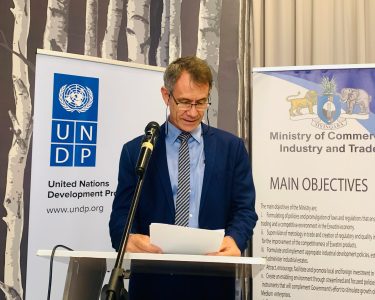
By Jabu Matsebula
Every 25 years – whether by coincidence or design, Eswatini introduces a new thought. In 1973 it was a new constitutional dispensation to develop the Tinkhundla. 25 years later in 1987, it started Vision 2022 which expired last year.
This time, the country is challenged to focus on national cohesion, set credible oversight and implementation systems, and then commit to making sure that the vision is actually achieved.
This week, business is jittery. Everyone is nervously eyeing the clock as April 12 next week approaches. Ears are primed to hear what the new national bogeyman, the Commander might announce. Should he do, no one will be sure what the right thing to do will be. Whether or not people obey, it will amount to the same state of anxiety during which the wise would rather be safe than sorry.
Last year when 2022 arrived, no one knew what to do to celebrate the end of the 25 years of Vision 2022. The 25 years of the National Development Strategy (NDS) ended buried in the traumas of Covid-19 contagion and protests.
Constitution
But 50 years earlier, another major national project was started and never completed. April 12 next week will mark the 50th anniversary of the 1973 suspension of the 1964 Constitution. Now much maligned and much misunderstood, the 1973 decree was supposed to start a proud new constitutional evolution towards a homegrown Constitutional dispensation.
Instead, the reform process, announced as an experiment was forgotten and abandoned. Young people now turn to it for motivation for regular protest. Today at least 75% of the population is under the age of 34. The other 20% who are under 60 were little children in 1973. The other 5 per cent who are between 65 and 100 are geriatrics who cannot remember much. Yet the subject of the 1973 decree never fails to find some relevance in whatever public grievance.
It is popular to always find a way to blame colonialism for our problems. In this case, blaming the British is relevant. They should have known better, instead of putting us on the path to the 1973 Decree as if they were not familiar with how monarchies work.
Except for a brief 11 year-republic (1649 – 1660), the British have always been a Monarchy and therefore also understood the architecture of Swaziland as a Monarchy. Queen Victoria became Empress in 1837 when Somhlolo had made several unsuccessful overtures to secure the British alliance.
King Sobhuza II
Benjamin Disraeli as Prime Minister recognized Swaziland as a state with borders, a monarchy with a functioning government, a foreign policy and a military capacity for offence and defence. Indeed the first Anglo-Swazi official interaction in 1879 was over a British request for King Mbhandzeni to help the British in the Transvaal and Natal in return for a treaty of friendship and respect for perpetual Swaziland sovereignty.
This was endorsed in the 1881 First Swaziland Convention in which Britain instructed the Transvaal Republic to respect Swaziland’s political and territorial integrity. King Sobhuza ll was 3 years old when Queen Victoria died in 1901. King Sobhuza invited King George VI with his wife, Queen Elizabeth and the Crown Princess, later Queen Elizabeth II to inspect a guard of honour mounted by traditional regiments when he visited Nhlangano in 1947.
Read More: The oracles suggest it’s an auspicious time to fly again
King Sobhuza II was invited as head of state to Queen Elizabeth II’s Coronation. British Prime Minister Harold MacMillan visited Swaziland and met King Sobhuza II in 1961 to inform him of the British decision to grant the Kingdom independence. From here he proceeded to deliver his now famous Winds of Change speech in the South African Parliament in Cape Town. The Swazi King had no illusion that while the British were friendly, they would not think twice about throwing him under the bus if that served their interest.
Background to 1973
The 1973 Decree should not have surprised me. It was long in coming. After his installation in 1921, King Sobhuza II had gone to the UK to ask the British Government to rescind the extremely unjust land partition order of 1903.
The British assigned Sir George Grey to carve up the country into three portions – crown land to be owned by the government; private title deed land (TDL) to preserve the rights largely of Afrikaner farmers and Swazi Nation Land (ticintsi) under customary law administration where all Swazis were ordered to converge by 1915.
The British had refused, citing the equivalent of ‘umlomo longacali manga.’ The British told them what had been done in the name of their Kings and Queens in the interest of the empire would not be undone.
The land partition had caused extreme poverty and hardship and was extremely unpopular. King had imagined that when independence came, the British would peacefully pack their bags and return to the UK, leaving emaSwati to take care of business under organic structures as an independent people.
Independence
But the first item of independence preparations was an independence Constitution. The drafting process was inclusive and free for any who could register a political party. Even non-Swazis (John ‘JJ’ Nquku had arrived in Swaziland on a scooter in 1930 and quickly formed the first party, SPP (Swaziland Progressive Party) in 1961) and took a seat at the constitution drafting table. King Sobhuza II was aghast at what he considered a totally alien arrangement.
This prompted the British to impose a template Westminster Constitution, which King Sobhuza rejected. He suggested a plebiscite to consult the people. Of the 124,380 people who voted in the referendum, 124,218 or 99.87% were against the imposed constitution.
The British ignored the referendum result and set general elections for the legislative assembly for June 1964. By stubbornly forcing a rejected constitution, they planted the first seeds for the 1973 decree. They also poisoned a future democracy with the bad lesson that the vote did not really matter, that it was OK if sometimes the authorities do what they want even if it is against the wish of the people.
Read More: Indlovukazi calls on women to stop looking down upon each other
What did the British expect? The monarchy’s rejection of multiparty politics was well known. However this also directly meant that come elections, the aristocracy would not be represented in Government. So in April, only two months before the 1964 elections, King Sobhuza II surprisingly formed the Imbokodvo National Movement.
Imbokodvo
He presented Imbokodvo as a charmed stone that relied on the assistance of frustrated rivals who would fling it across a flooded river for it to magically transform into a person. The allegory was to prove its truth. The Imbokodvo swept the polls, repeatedly winning all seats in 1964 and in 1967 to form the government. When they lost only one constituency in the 1972 elections they acted as all spoilt children who stop the game, put the ball under the armpit and walk away.
What should not be ignored is that the 1973 Decree followed a legitimate political process. The Mbokodvo had Parliament motion to abandon the constitution. The opposition NNLC (Ngwane National Liberatory Congress) ritually objected. The House voted and the majority party won. Subsequently, from Parliament, Prince Makhosini surrendered the constitution document to King Sobhuza II at Lobamba.
Attorney General David Charles Cohen who was standing by subsequently produced the legal instrument that transferred legislative, administrative and judicial power to the monarchy.
The decree was supposed to be the start of an organic constitutional evolution to provide something that would represent the genuine aspirations of Swazis. To a lack of capacity and political will, the effort ran out of steam and direction. Half a century later, the people in frustration point at a Tinkhundla System that no one seems to quite embrace.
First World
Eswatini still aspires for a first-world status. The discussion of the Governance reforms that aim at promoting inclusion, social cohesion and motivation, especially to the youth to see bright futures in their country is overdue.
Communities around the world are concentrating on pathways for economic recovery, creating new development opportunities; increasing employment and income opportunities; creating wealth and promoting happiness. There is no reason why Eswatini cannot do the same. But it can’t if every few weeks, one or the other of its long-festering sores ruptures – disrupting everything from education, health, transport, commerce and other important areas of public life.



